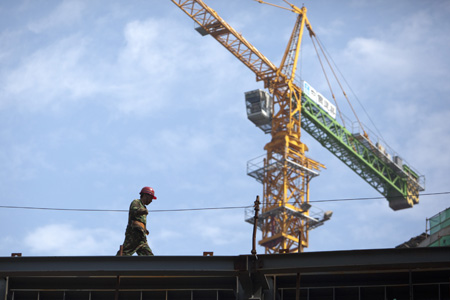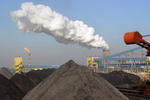Chinese PMI rose in August
Updated: 2011-09-02 11:08
By Chen Jia (China Daily)
|
|||||||||||
 |
|
A construction site in Beijing. China's official purchasing managers' index rose to 50.9 in August from a 29-month low of 50.7 in July. [Photo / Agencies] |
Expansion seen in manufacturing activity after months of contraction
BEIJING - China's manufacturing production rose slightly in August, ending a four-month period of consecutive declines.
However, falling export orders and increasing input costs may still pose a downside risk to economic growth, analysts said.
The purchasing managers' index (PMI), a composite indicator of operating conditions in the manufacturing sector, rose to 50.9 in August from a 29-month low of 50.7 in July, according to data from the China Federation of Logistics and Purchasing (CFLP) on Thursday.
The rise may indicate that economic growth has stabilized after a slowdown in the first half of the year, according to a statement on the website of the CFLP. A PMI reading above 50 indicates an expansion in manufacturing activity from the previous month, while a reading below 50 shows a contraction.
Premier Wen Jiabao wrote in an article published on Thursday that the slowdown in economic growth was partly a result of the country's macroeconomic tightening policies, and it is within the expected range.
The top priorities for the government are to stabilize prices and tame inflation, the Premier said.
An subindex of new export orders in August decreased to 48.3 from 50.4 in July, indicating a contraction for the first time since May 2009, according to the CFLP.
Zhang Liqun, a macroeconomic analyst with the State Council Development Research Center, said the rapid decline in the export order index might signal a downturn in exports during the coming months, because of predicted lower demand from the eurozone and the United States as they battle with potential sovereign debt crises.
A subindex of input costs advanced to 57.2, 0.9 point higher than in July. According to the CFLP, the key drivers were higher prices for raw materials and fuel, which may continue to fuel inflation and the expectation that the US may launch a third round of "quantitative easing", although the chairman of the US Federal Reserve Board, Ben Bernanke, appeared reluctant to implement "QE3" when he spoke recently at a forum at Jackson Hole, Wyoming.
Zhang said profit is almost negligible for many small and medium-sized companies as they struggle with the increasing pressure of high production costs.
A statement from China's National Bureau of Statistics said that manufacturing companies are still facing difficulties, including a lack of cash flow, the high cost of raw materials and labor, and energy shortages.
Thursday's data means that the central bank is less likely to further raise interest rates or the reserve-requirement ratio for lenders for the rest of the year, according to Sun Chi, an economist at Nomura Securities Co Ltd. "China's policy stance is firmly in a 'wait and see' mode," he said.
HSBC PLC also released its August PMI data on Thursday. The number came in at 49.9, an increase from July's 49.3, and showing a negligible rate of deterioration.
"With both output and employment indexes rebounding, these data indicate that China will only see moderate growth in the coming months, rather than a hard landing," said Qu Hongbin, chief China economist and the co-head of the Asian Economic Research Department at HSBC.













